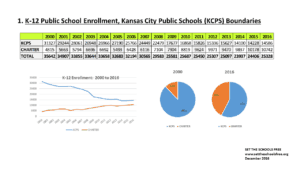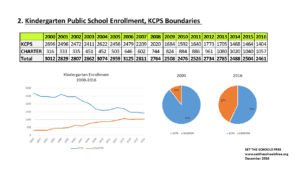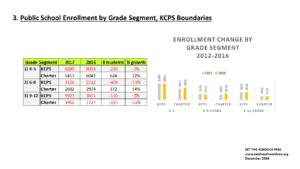Happy Holidays from Set the Schools Free. As a 2016 wrap-up I’ve gathered and summarized the public school enrollment data for KCPS and charter schools that has informed my writing over the past year, making it more readily available in one post. (Less talk, more numbers!) This data spans from 1999-2000, the first year charter schools operated in Kansas City, to the 2015-2016 school year.
Click here or on any graphic to access all 3 slides in .pdf format.
Note: “2016” is the 2015-2016 school year, not the current academic year. DESE will release 2016-2017 enrollment data in January 2017.
Happy New Year, and see you in 2017!



Interesting data. What does it mean for KC elementary schools?
If projected future enrollment of charters is factored in what do the trends look like?
What happens when/if the trend lines cross, i.e. more charter school students than KCPS?
And if the lines cross what is the likely make-up of students still left in KCPS?
What new educational methods will be needed to educate effectively the most at-risk students
who are least likely to opt for charters?
Thanks for your comment and questions, Bill.
You asked what these data mean for KC elementary schools. I think the answer to this question really depends on whether or not you think having some type of centrally-coordinated public school system is important for our district.
If you don’t think a centrally-coordinated system is important then I’m not sure the data really matter that much – except to confirm that Kansas City parents have an increasing appetite for public charter schools. Which is, in turn, being met by a growing – although very fragmented – charter sector of variable quality. Problem solved! (Though obviously as our system becomes more fragmented, there is more of a need for some type of coordinating entity to step into the fray and make sense of it all.)
If you do think a centrally-coordinated public school district is important, it’s a different conversation. From a survival standpoint, declining KCPS elementary enrollment is troubling because it’s the biggest market segment KCPS serves – the fattest part of the K-12 student pipeline, and the part that brings in the most per pupil revenue. It’s also the market in which KCPS is facing the most competition.
Over the last five years overall K-5 enrollment has contracted by 3%, which doesn’t seem like that much overall. Until you consider the K-5 charter enrollment grew by 12%. And that four new charter elementary programs started this 2016-2017 academic year (one is a KCPS-sponsored charter school). I’m not sure if any new schools will be opening this year, though of course recently opened schools will continue to add grades.
All in all, declining K-5 enrollment represents a pretty significant challenge for KCPS. It’s worth asking, I think, if the solutions being proposed to address this decline are commensurate with the real scope of the challenge KCPS is facing. Enter the role of innovation…
In any event, there was a slight bump in KCPS enrollment during the 2015-2016 school year. Let’s see what the numbers look like in 2016-2017. That data should be out shortly, I’ll be sure to share it here.
I’ve written another blog-length post – and have only responded to your first question! To keep it short, I’ll use your other questions as inspiration for my next posts – they are important to consider and, I think, get to the core of what type of public education system we really want for our children, especially for those that are most vulnerable. Thanks again for your questions.
A reader pointed out that the Independence annexation of 7 KCPS schools in 2008-2009 made up a significant part of the 21% drop in KCPS enrollment between 2007/08 and 2008/09. KCPS lost 4800 students total between those two academic years; 2700 are attributed to the annexation. Thanks for this feedback.
Does enrollment into Pre-K programs factor into this anywhere? I am just curious because I know that KCPS added Pre-K in 2016 and attracted some families that would not otherwise have looked at KCPS for their kids. The question is whether any of those families will stay in the district after Pre-K, or whether they will move onto Charters. I also wonder if there would be some worth in breaking out KCPS into magnets/signature/ KCPS charter just to see what those numbers are doing.
Pre-K enrollment is not included in the data I just posted – I wanted to keep an apples to apples comparison over time, and the district’s investments in Pre-K have varied over the years, making it difficult to make that comparison. (Also, charter schools, for the most part, don’t have pre-schools). I think you’re right that the latest (free) Pre-K initiative has attracted families that may not otherwise have considered KCPS for elementary school. It will be interesting to see the retention data next year, and whether or not families are staying/whether this recruitment strategy works over time.
I agree that there’s a lot of value in breaking out KCPS enrollment data into signature and neighborhood schools and looking at these numbers next to charter enrollment over time – it shows the real choices parents are making about where to send their kids to school. During the 2015-2016 school year about 25% of KCPS students were enrolled in signature schools. When combined with charter enrollment, 6 of 10 students within our district boundaries attended “schools of choice” last year – that is, schools otherwise not associated with their zip code. I’ll put another slide together tracking this data over time and and will post it. Thanks for the suggestion.
Note: like charter schools, KCPS signature schools are “schools of choice” and require parent and/or student motivation to apply. They are thus as subject to selection bias (“creaming”) as charter schools are. I mention this because when charter schools outperform KCPS schools, this issue of “creaming” is one of the first criticisms leveled against them – that they are successful because of the students they attract, rather than anything they may be doing in the classroom to help students succeed. I’ve never heard that same criticism leveled against signature schools, though.